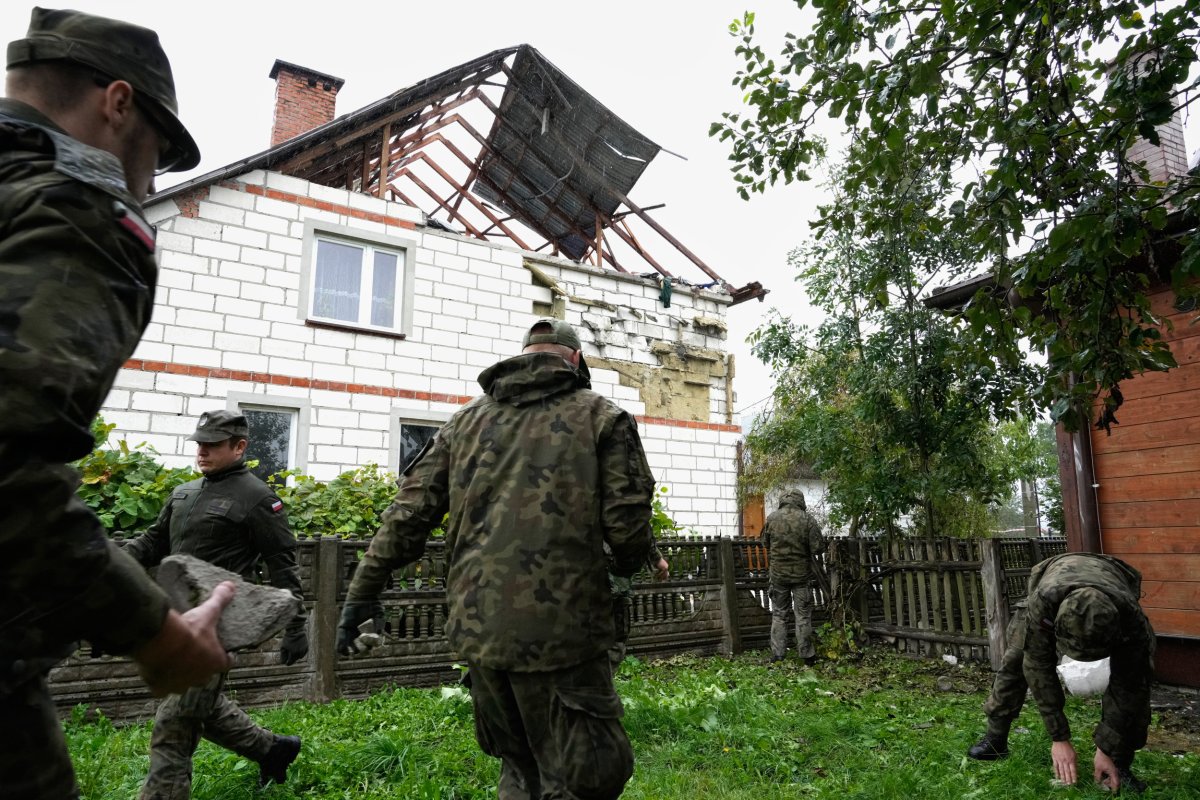-
Jayden Daniels on injury concerns: "Everybody can stop talking on social media about the brace…I am good" - 17 mins ago
-
Tension Growing Between Eagles’ Jalen Hurts, A.J. Brown: Report - 18 mins ago
-
Nicole Kidman’s first appearance after Keith Urban divorce filing - 38 mins ago
-
Cowboys’ Trevon Diggs Could Face NFL Punishment After Swinging on Jets WR - 58 mins ago
-
Jacory ‘Bill’ Croskey-Merritt Runs Away With LFG Player of the Game vs. Chargers - 60 mins ago
-
Indonesia School Collapse Death Toll Reaches 49, 14 Still Missing - 2 hours ago
-
‘Going to Cancún:’ Big Papi Talks About Yankees’ Chances After Game 2 Loss - 2 hours ago
-
Bunnie Xo defends sexy Scooby-Doo Velma costume amid social media hate - 2 hours ago
-
Bengals Considering Making Major Change After Loss to Lions - 2 hours ago
-
Joey Logano Advances After Denny Hamlin’s Move in Wild Last Lap at Charlotte - 2 hours ago
Poland Will Take ‘Toughest’ Measures Over Russia Drone Incursion: Deputy PM
Polish Deputy Prime Minister and Foreign Minister Radoslaw Sikorski has told Newsweek that his nation is working with allies to adopt stringent steps in response to alleged Russian drones crossing into Poland amid the war in Ukraine.
The comments came about a week after a swarm of drones entered Polish airspace from neighboring Belarus, a Russian ally, as well as from Ukraine. Warsaw determined the unmanned aerial vehicles to be of Russian origin, having coincided with a massive attack against various sites in western Ukraine, which also borders Poland.
While Russian officials have denied responsibility, Sikorski rejected these narratives, instead saying he sees the incursion as a deliberate effort by President Vladimir Putin to probe NATO’s resolve.
“Such incidents happened before but this time our airspace was violated on purpose,” Sikorski told Newsweek. “It was not a mistake. It was a 7-hours-long air operation. 21 drones. The Russian MOD says that this accident was a slip and the Russian Ambassador to the UN claims that it was technically impossible for those drones to fly more than 700 km.”
“Both cannot be right,” he added. “In fact, neither is.”
Rather, Sikorski argued, the “Kremlin wanted to test the readiness of NATO Allies,” to which “we reacted—Poland invoked consultations under Article 4 of the North Atlantic Treaty, and NATO launched operation Eastern Sentry.”
“Two days after the incident, Poland called for an emergency session of the UN Security Council,” Sikorski said. “Almost 50 countries—including the whole EU— issued a joint statement. And we will do more to ensure that our people are safe. It all shows once again that with an aggressor and a liar like Putin, only the toughest counter-pressures work.”
WOJTEK RADWANSKI/AFP/Getty Images
Poland and the Eastern Front
The comments follow Sikorski’s wide-ranging interview with Newsweek published September 7, just three days before the drone incident. Sikorski at the time called on allies to double down on pressure against Russia and assistance to Ukraine.
He also referenced both historical and contemporary events in discussing how the former Soviet satellite state that transitioned to democracy in 1989 has since embarked on a historic campaign of military investiture, spending more than any other NATO member state on defense as percentage of GDP while mounting the alliance’s third-largest standing army, behind only the United States and Turkey.
Poland’s position on NATO’s eastern flank has garnered new significance since unrest first erupted in Ukraine following a 2014 popular uprising that installed a pro-West government, followed by Russia aiding separatist rebels in the east and seizing control of the Crimean Peninsula in the south.
Then, too, Warsaw invoked Article 4, which calls for emergency consultations among member states. NATO’s response then culminated in the deployment of four multinational battle groups in the Baltics and in Poland, where the battalion is led by the U.S.
The developments at the time marked the largest military mobilizations since the Cold War, yet they were dwarfed by the large-scale invasion of Ukraine launched by Russia on February 24, 2022. That same day marked the second time Poland invoked Article 4, doing so alongside several other NATO states in Eastern Europe, resulting in ongoing efforts to aid Ukraine via economic and weapons shipments.
The war continues today with no apparent clear path to victory for either side. But after years of dueling offensives and a bloody stalemate, Russian troops are once again advancing, though gradually and at great cost, threatening to undermine Ukraine President Volodymyr Zelensky’s hand at ongoing peace talks backed by U.S. President Donald Trump.
Meanwhile, Polish Prime Minister Donald Tusk has warned that the recent drone incident constituted “the closest we have been to open conflict since World War II.”
EU High Representative for Foreign Affairs and Security Policy Kaja Kallas also remarked on the unprecedented nature of the incursion, calling it “the most serious European airspace violation by Russia since the war began, and indications suggest it was intentional, not accidental.”

Czarek Sokolowski/AP
Malice or Mistake?
The sudden entry of the drones into Polish airspace triggered a NATO Quick Reaction Alert, with Poland and allies scrambling fighter jets to shoot down the incoming UAVs.
Russia has yet to provide a comprehensive explanation for the incident, though officials have denied any intentional effort to target Polish territory, an act that could potentially lead to the invocation of NATO’s Article 5 mutual defense clause.
Shortly after the incursion, the Russian Embassy in Poland told Newsweek that Warsaw had not provided sufficient proof to tie the UAVs to Moscow.
“The Polish side once again failed to present evidence of the Russian origin of the objects that entered Polish airspace (and there is no reason to expect that it will), and completely groundlessly accused Russia of provocative actions,” the embassy said at the time.
The Regional Prosecutor’s Office in Lubin later assessed that at least some of the drones involved in the incident were Gebara models, reported to be a cheaper and simplified variant of the Geran, a loitering munition or “suicide drone” developed under license from Iran. The Polish investigation did not find any explosive materials associated with the drones, leading to the conclusion they may have been decoys.
The Russian Defense Ministry acknowledged in a statement after the incident that it coincided with an attack aimed at the “decommissioning of enterprises of the military-industrial complex of Ukraine,” but “unequivocally confirmed that targets for destruction on the territory of the Republic of Poland were not planned.” The Russian military also stated that the flight range of the drones used in the attack “does not exceed 700 kilometers.”
Thus, the ministry said, “these specific facts completely debunk the story again spread by Poland to further escalate the Ukrainian crisis.”
The Russian Foreign Ministry backed the military’s claims, and offered to participate alongside the Russian Defense Ministry in bilateral talks with Poland over the issue.
“Despite the obvious inconsistency of Warsaw’s allegations, and seeking to fully clarify the incident for all sides interested in preventing the further escalation of the situation, the Defense Ministry of the Russian Federation has stated readiness to hold consultations on this issue with the Defense Ministry of the Republic of Poland,” the Russian Foreign Ministry said. “The Foreign Ministry of Russia is ready to contribute to these efforts.”
Newsweek has reached out to the Russian Embassy in Poland for additional comment.
While NATO member states have been largely unified in their condemnation of Russia over the incident, Trump has also questioned allies’ suggestion that the drone incursion was an intentional act on the part of the Kremlin, telling journalists last Thursday “it could have been a mistake, but regardless, I’m not happy with anything having to do with that whole situation.”
Tusk hit back at Trump’s remarks via social media. He wrote the following day on X: “We would also wish that the drone attack on Poland was a mistake. But it wasn’t. And we know it.”

OLESYA KURPYAYEVA/AFP/Getty Images
Troops on the Move
With tensions running high, NATO has vowed to once again bolster defenses along its eastern frontier. Operation Eastern Sentry, launched last Friday, remains ongoing, thus far including fighter jets from Denmark, France, Germany and the United Kingdom, as well as vessels from Finland and Latvia.
Simultaneously, Russia and Belarus commenced the week-long Zapad (or West) 2025 joint exercises, the first of their kind since the war began. The maneuvers were carried out with participants from a number of partnered countries, including India, across various sites in both nations, including Russia’s exclave Kaliningrad region that borders Lithuania and Poland.
Poland has closed its border with Belarus throughout the exercises over security concerns, potentially stemming from the earlier build-up of Russian and Belarusian forces during the Zapad 2021 exercise that later crossed into Ukraine just months later.
Poland is also now conducting another set of exercises known as Iron Defender-25, involving tens of thousands of NATO troops, most of them Polish, which began in mid-August.
The flurry of military activity has only further exacerbated frictions in Europe and amplified calls among NATO and Russia to shore up security measures on their respective sides.
Sikorski, for his part, has recently advocated for the implementation of a no-fly zone extending over Ukraine, a measure that would necessitate NATO directly shooting down Russian drones involved in the war.
To this, Russian Security Council Deputy Chair Dmitry Medvedev has warned such a move “will mean only one thing: NATO’s war with Russia.”
Source link






























